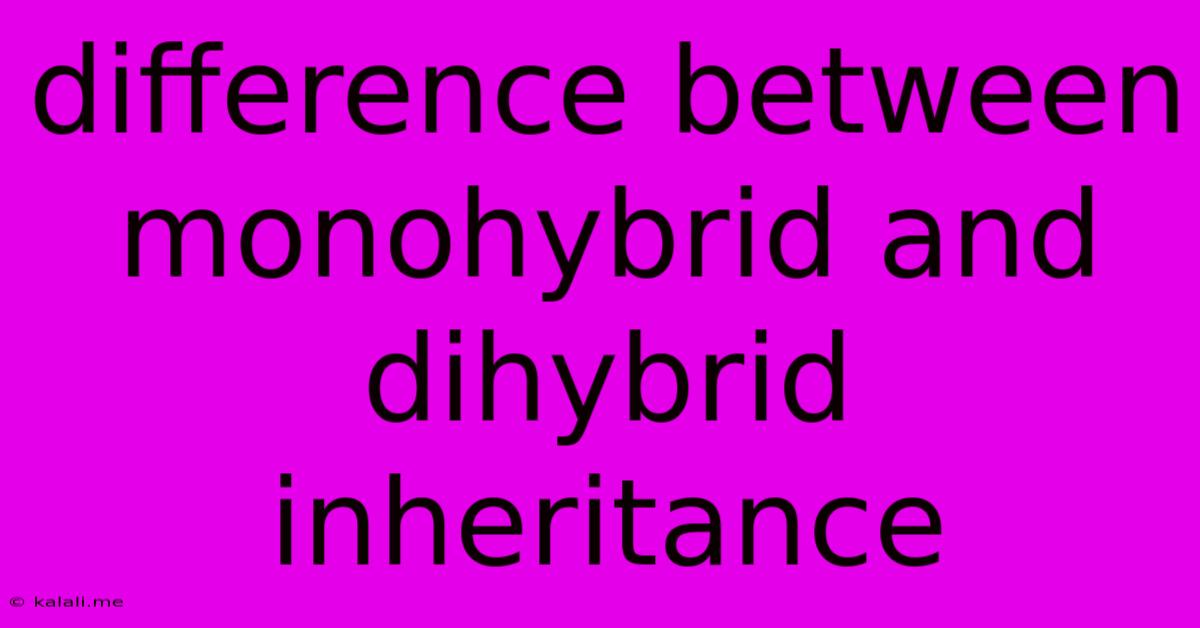Difference Between Monohybrid And Dihybrid Inheritance
Kalali
Jun 15, 2025 · 3 min read

Table of Contents
Understanding the Difference Between Monohybrid and Dihybrid Inheritance
Understanding the principles of inheritance is fundamental to grasping the complexities of genetics. While seemingly complex, the core concepts are relatively straightforward. This article will delve into the key differences between monohybrid and dihybrid inheritance, two crucial concepts in Mendelian genetics. By the end, you'll be able to confidently differentiate between these inheritance patterns and apply your understanding to various genetic problems.
What is Monohybrid Inheritance?
Monohybrid inheritance focuses on the inheritance of a single gene that controls a single characteristic or trait. Think of it as tracking one specific feature, like flower color in pea plants (purple or white). Gregor Mendel, the father of modern genetics, used monohybrid crosses extensively in his pea plant experiments to establish fundamental principles of inheritance. A classic example is crossing homozygous dominant (PP – purple flowers) and homozygous recessive (pp – white flowers) pea plants. The resulting offspring (F1 generation) all exhibit the dominant phenotype (purple flowers), showcasing the concept of dominance and recessiveness. Subsequent crosses within the F1 generation (self-pollination) reveal the 3:1 phenotypic ratio (3 purple: 1 white) characteristic of monohybrid crosses. This ratio reflects the underlying genotypic ratio (1 PP: 2 Pp: 1 pp). Analyzing these ratios allows geneticists to predict the probability of offspring inheriting specific traits.
Key characteristics of monohybrid inheritance:
- Involves one gene
- Focuses on one trait
- Results in a 3:1 phenotypic ratio in the F2 generation (in a simple dominant-recessive case)
- Uses Punnett squares for easy visualization of possible offspring genotypes and phenotypes.
- Illustrates the concepts of dominance, recessiveness, homozygous and heterozygous genotypes.
What is Dihybrid Inheritance?
Dihybrid inheritance, on the other hand, examines the simultaneous inheritance of two different genes, each controlling a separate trait. For instance, consider pea plants where one gene determines flower color (purple or white) and another determines seed shape (round or wrinkled). A dihybrid cross involves crossing individuals that are heterozygous for both traits (e.g., PpRr x PpRr). The analysis becomes more complex, resulting in a greater variety of possible offspring genotypes and phenotypes. Unlike the straightforward 3:1 ratio seen in monohybrid crosses, dihybrid crosses yield a 9:3:3:1 phenotypic ratio in the F2 generation when considering simple dominant-recessive relationships for both traits. This ratio represents the various combinations of the two traits. For example, in our pea plant example, it would show the frequency of purple round, purple wrinkled, white round, and white wrinkled seeds.
Key characteristics of dihybrid inheritance:
- Involves two genes
- Focuses on two traits
- Results in a 9:3:3:1 phenotypic ratio in the F2 generation (in a simple dominant-recessive case with independent assortment)
- Requires larger Punnett squares (16 squares) for complete visualization
- Illustrates independent assortment: the inheritance of one gene does not influence the inheritance of the other.
Key Differences Summarized
| Feature | Monohybrid Inheritance | Dihybrid Inheritance |
|---|---|---|
| Number of Genes | One | Two |
| Number of Traits | One | Two |
| F2 Phenotypic Ratio | 3:1 (simple dominant-recessive) | 9:3:3:1 (simple dominant-recessive with independent assortment) |
| Punnett Square Size | 4 squares | 16 squares |
| Concepts Illustrated | Dominance, recessiveness, homozygous, heterozygous | Dominance, recessiveness, homozygous, heterozygous, independent assortment |
Understanding these differences is vital for predicting the probability of inheriting specific combinations of traits and for interpreting the results of genetic experiments. While both monohybrid and dihybrid crosses utilize fundamental Mendelian principles, the complexity increases significantly when dealing with multiple genes and traits, highlighting the intricate nature of inheritance patterns.
Latest Posts
Latest Posts
-
Bank Account Closing Letter Word Format
Jun 15, 2025
-
The First Five Multiples Of 9
Jun 15, 2025
-
What Is The Factor Of 112
Jun 15, 2025
-
Difference Between Electron Affinity And Electronegativity
Jun 15, 2025
-
Which Of The Following Is Not A Property Of Metal
Jun 15, 2025
Related Post
Thank you for visiting our website which covers about Difference Between Monohybrid And Dihybrid Inheritance . We hope the information provided has been useful to you. Feel free to contact us if you have any questions or need further assistance. See you next time and don't miss to bookmark.